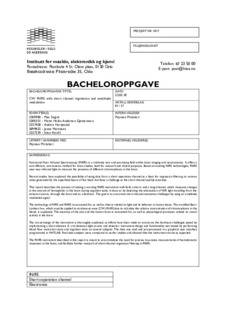| dc.description.abstract | Functional Near Infrared Spectroscopy (fNIRS) is a relatively new and promising field within brain imaging and neuroscience. It offers a cost efficient, non-invasive method for brain studies, both for research and clinical purposes. Based on existing NIRS technologies, fNIRS uses near infrared light to measure the presence of different chromophores in the brain.
Recent studies have explored the possibility of using data from a short separation channel as a basis for regression filtering to remove noise generated by the superficial layers of the head, but faces a challenge as the short channel quickly saturates.
This report describes the process of making a working fNIRS instrument with both a short- and a long-channel, which measures changes in the amount of hemoglobin in the brain during cognitive tasks. It does so by detecting the attenuation of NIR light travelling from the emission source, through the brain and to a detector. The goal is to overcome short channel saturation challenges by using an amplitude modulated signal.
The technology of NIRS and fNIRS is accounted for, as well as theory related to light and its behavior in human tissue. The modified Beer-Lambert law, which must be applied to continuous wave (CW) fNIRS data to calculate the relative concentration of chromophores in the blood, is explained. The anatomy of the skin and the human brain is accounted for, as well as physiological processes related to neural activity in the brain.
The circuit design of the instrument is thoroughly explained, as efforts have been made to overcome the hardware challenges posed by implementing a short distance (1 cm) between light source and detector. Instrument design and functionality was tested by performing blood flow restriction tests and cognitive tests on several subjects. The data was read and pre-processed in a graphical user interface programmed in MATLAB. Final data analyses were compared to earlier studies and showed that the instrument works as expected.
The fNIRS instrument described in this report is meant to accommodate the need for precise, low-noise measurements of hemodynamic responses in the brain, and facilitate further research of short-channel regression filtering in fNIRS. | |
